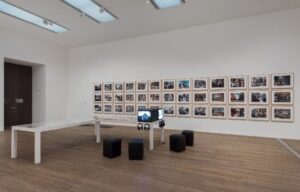My curatorial commitment
-
Critical thinking towards oneself so that unconscious prejudices can be reviewed
-
Have a relationship with artists as equals and never use their power or influence to force them to associate with them
-
Consider the impact on the environment as important
-
Selecting artworks with an impartial perspective
-
Eliminating dominant voices
-
Being inclusive
・What specific issues would guide you? Why are these issues so pressing?
Women and minorities, particularly non-white women and LGBTQI+, are underrepresented in museum collections and exhibitions (Brulon, 2019). Hence, all my principles of eliminating dominant views, being inclusive and acting in a community context, prioritise accessibility for all, including racial and gender equality. Moreover, it can be argued that there are not enough open resources within the museum community to address the challenges to minorities. The history of European museums cannot be separated from the history of European colonial planning based on assumptions of Western superiority, racial hegemony and nation-state building (Modest, 2012). There is a need for curation that can facilitate public discussion of these issues within the museum space, without separating these subjects from the public. To address this issue, I suggest that the overall experience in the space needs to be able to raise visitors’ awareness of the subject matter, through active discussion of topics such as colonialism and feminism in curatorial activities and self-criticism of their own prejudices.
・How would you actively encourage change?
It is about actively curating spaces that highlight and lift up the artists’ experiences, histories and perspectives. For example, Soul of Nation: Art in the Age of Black Power at Tate Modern in 2017 focused on the works of black artists from the American Civil Rights Movement era, confronting the inevitable challenges by addressing marginalised voices.Whitley, the curator of the exhibition, states that ensuring a pathway to entry level for black and minority ethnic talent means that they are able to participate in the kind of system they desire (Whitley and Genesis, 2020). In order to bring marginalised racial groups onto a common stage through curation, I argue that curators have an ethical obligation to create opportunities for artistic practice in which they can participate.

Soul of a Nation: Art in the Age of Black Power, installation view, Tate Modern (2017)

Soul of a Nation: Art in the Age of Black Power, installation view, Tate Modern (2017)
・Who would you collaborate with to facilitate this change?
To facilitate these changes, it is necessary to work together with diverse artists, writers and collectors, independent of context. Museums and gallery spaces as places of activity should be considered as ‘commons’, as platforms where all kinds of people can have their voices reverberate.
・How would you ensure that these changes had longevity?
To be long-lasting, the declaration of this change as a norm needs to bring curation and ethics closer together. Chen (2023) states that curation can be viewed not simply as selection, design, interpretation and presentation, but as ‘caring’ and ‘care-taking’ revealed in intersubjective and intimate relationships, extending the domain of curation to ethics.
Notes:
Brulon, B. (2019). Museus, mulheres e gênero: olhares sobre o passado para possibilidades do presente. cadernos pagu, e195515.
Chen, M. (2023, October 25). Ethics of curating. Curatography.
Modest, W. (2012). We have always been modern: museums, collections, and modernity in the Caribbean. Museum Anthropology, 35(1), 85-96.
Reilly, M. (2018). Curatorial Activism. Towards An Ethics Of Curating. London: Thames & Hudson, 5, 214-225.
Whitley, Z and Genesis, C. (2020, Oct 28). Zoé Whitley and Chrystal Genesis in Conversation [Video]. Frieze.
https://www.frieze.com/video/zoe-whitley-and-chrystal-genesis-conversation
Exhibition: Soul of Nation: Art in the Age of Black Power (2017) At Tate Modern, London


Comments
I like your personal interests and research directions that you have already shown in your blog ~ the combination of “Street Art” and contemporary art must be a very interesting theme. And the fact that you thought of defining it in the first place is very rigorous and worth learning from.
I think the weekly blog could have a clearer theme. You could design your content module to include the exhibitions you see each week and other research to help you with your personal project. Also, the Blog could add more personalised reflections and go deeper into your research with research cases. You can start to introduce your ideas into your personal project and by doing so the progress of your personal project may also become clearer. For example, what stood out to you when you wrote about the Fruitmarket gallery? Did you think of anything new about their curatorial approach? Is there any element of ‘street art’ in there?
Looking forward to your content on what follows week 3~
I like….. that you have included images to support the content of your posts and that you have demonstrated a great level of development within your week 4 blog post in terms of the inclusion of a reference list and in-text references (you just need an in-text reference for Reilly), and examples of exhibitions.
I wish……that in your Week 2 post, you had been much more detailed and engaged with all aspects outlined in the blog toolkit on Learn. You need to have a reference list and in-text references to demonstrate the sources of your information. You also need to include images references.
You need to engage with contemporary art theory both in terms of the lecture and seminar readings and content, but also provide evidence of engagement in independent theoretical research. You should also refer to the development of your independent curatorial project and the group planning meeting each week, as well as any site visits.
I wonder…. if you spend time going through the blog requirements on the toolkit on Learn. Please ask me if you have any questions.